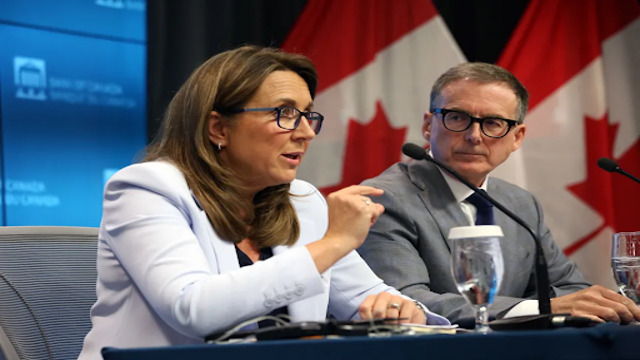
The Bank of Canada announced its last rate cut of the year, signalling a likely reduction in the frequency of future rate cuts. (Photo by Dave Chan/AFP via Getty Images) · DAVE CHAN via Getty Images
Economists anticipate that the Bank of Canada (BoC) will take a steadier approach to interest rate changes in 2025 compared to the dramatic shifts of 2024. Last year, five rate cuts brought the overnight rate down significantly from 5% to 3.25%, with the final cut of 50 basis points announced in December. However, future adjustments are expected to come at a slower pace, aligning with BoC Governor Tiff Macklem’s stated strategy of gradual monetary policy.
Recent data reveals that Canada's economy showed some resilience in October 2024, with real GDP increasing by 0.3%, driven by the oil and gas sector. However, November’s advance estimates suggest a slight contraction of 0.1%. These figures indicate that fourth-quarter GDP growth may fall short of the BoC’s 2% projection. Economists now foresee a modest 25-basis-point rate cut at the upcoming policy meeting on January 29.
While projections vary, economists agree that interest rates will continue to decline. BMO predicts the overnight rate will drop to 2.5% by mid-2025, while RBC anticipates a 2% rate by year-end, which it believes will balance economic growth and inflation targets. Similarly, CIBC and Desjardins forecast a 2.25% rate by late 2025, citing economic conditions that include slower population growth, potential U.S. tariffs, and the financial strain of higher mortgage renewal rates.
Economists also point out challenges ahead for the BoC. National Bank’s Daren King highlighted the need to address the economy’s output gap, requiring growth above its long-term potential to absorb unused capacity and lower unemployment. These obstacles make further rate cuts essential, though large adjustments like 50-basis-point cuts appear unlikely.
As 2025 unfolds, all eyes will remain on critical economic indicators, including employment and inflation data, to gauge how effectively the BoC manages this balancing act.















